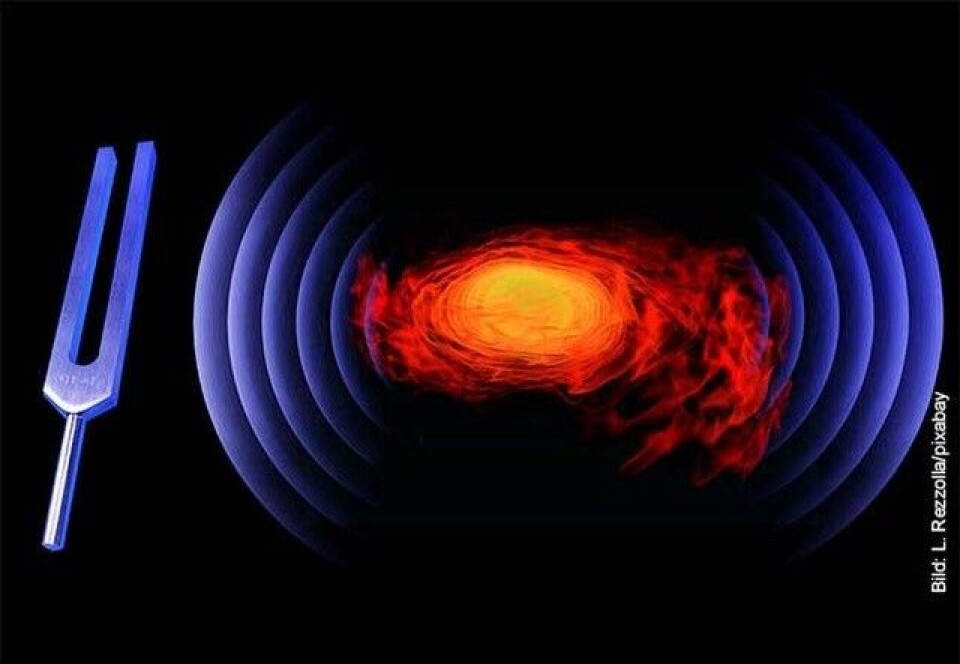THIS CONTENT IS BROUGHT TO YOU BY the University of Stavanger - read more
Like tuning forks in space:
A final pure tone reveals the mysterious interior of neutron stars
Researchers have identified a new way to probe the interiors of neutron stars by analysing gravitational waves from their collisions.

Neutron stars have a mass greater than that of the entire solar system. This immense mass is confined within a nearly perfect sphere that is only about a dozen kilometres in diameter. These stars are among the most fascinating astrophysical objects known to man.
The extreme conditions inside these stars make their composition and structure highly uncertain.
A unique opportunity to peer inside neutron stars
The collision of two neutron stars, such as the one observed in 2017, provides a unique opportunity to uncover these mysteries.
When two neutron stars orbit each other for millions of years, they slowly move closer together and emit gravitational waves. These are ripples or vibrations in space-time caused by massive objects that accelerate extremely fast.
The most intense emission occurs at and just milliseconds after they crash into each other.
The aftermath of such a collision produces a massive, rapidly rotating object, known as a post-merger remnant. This remnant emits gravitational waves in a strong but narrow frequency range.
Researchers study these waves because they hold crucial information about the ‘equation of state.' This equation describes how nuclear matter behaves at extreme densities and pressures, such as those found inside neutron stars.
A pure tone emerges in the aftermath
A team of researchers from the University of Stavanger and Goethe University in Germany has made a groundbreaking discovery. As the post-merger signal weakens, it becomes increasingly 'pure.' It tends towards a single tone, much like a giant tuning fork resonating after being struck.
The researchers have called this phase the ‘long ringdown.’ They found a strong connection between its unique characteristics and the properties of the densest regions in neutron-star cores.
The results were recently published in Nature Communications.
Just as tuning forks made of different materials produce distinct pure tones, neutron star remnants vibrate at different frequencies. Their frequency depends on their internal structure. By detecting and analysing this long ringdown signal, researchers can uncover the composition of neutron stars. This helps them gain deeper insights into their interiors.
“With this new understanding of the relationship between gravitational wave emission and the properties of neutron star cores, we are now equipped to study the exotic phases of matter that may exist under these extreme conditions," says Aleksi Kurkela.
He is an associate professor at the University of Stavanger's Department of Mathematics and Physics. Kurkela was part of the research team behind the new study.
"It will be incredibly exciting to test various theoretical ideas about matter at the highest densities found in the universe,” he says.
A step towards understanding the universe's densest matter
Using advanced computer simulations, the researchers showed that analysing the long ringdown can greatly improve our understanding of how matter behaves at extreme densities.
This is especially important because no direct measurements currently exist for such high-density environments.
Their findings pave the way for a better understanding of dense neutron star matter. Future observations of neutron star mergers will provide even more insights.
Current gravitational wave detectors have not yet observed the post-merger signal. However, researchers are optimistic that next-generation detectors will make this possible.
One such detector is the Einstein Telescope, which is expected to become operational in Europe within the next decade.
When that happens, the long ringdown will serve as a powerful tool for exploring neutron stars. It will help reveal the secrets of matter at its most extreme.
Reference:
Ecker et al. Constraining the equation of state in neutron-star cores via the long-ringdown signal, Nature Communications, vol. 16, 2025. DOI: 10.1038/s41467-025-56500-x

This content is paid for and presented by the University of Stavanger
This content is created by the University of Stavanger's communication staff, who use this platform to communicate science and share results from research with the public. The University of Stavanger is one of more than 80 owners of ScienceNorway.no. Read more here.
More content from the University of Stavanger:
-
How the Vikings protected themselves from attacks
-
Could scented books encourage more kids to read?
-
Artificial intelligence could improve the quality of life for more patients following a stroke
-
Cathedral's lost treasures uncovered
-
Norwegian researchers can contribute to changing the Big Bang theory
-
Archaeologists may have found a marketplace from the Viking Age




































